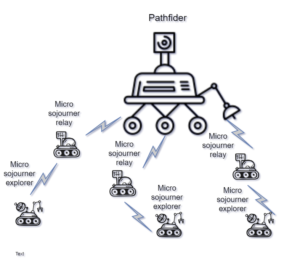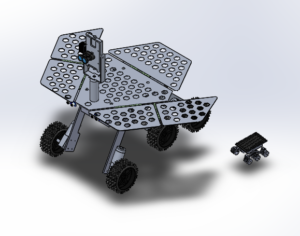NASA JPL: Fractured Spacecraft Project Overview
by: Kevin Gomez (Project Lead)
Edward Patterson (Project Member)
Table of Contents
Introduction
This semester a team of four members undertook preliminary research of three challenges offered by NASA’s Jet Propulsion Laboratory (JPL). Fractured Spacecraft is one project brought forward for consideration. The Fractured Spacecraft groundwork will provide a stepping stone in the exploration of the fractured rovers and spacecraft systems by exploring their feasibility through the mission demonstration. The design of the resulting project is a two semester mission with collaboration between the Computer Engineer & Computer Science department, Mechanical and Aerospace department, and the Electrical Engineering department at Long Beach California State University, with the guidance of JPL.
Mission Profile
The number of interplanetary spacecraft headed to mars is increasing. Missions such as SpaceX’s falcon heavy and NASA JPL’s InSight seek to further increase the number of spacecraft surrounding the red planet. Space launches are so prolific that InSight was forced to launch in the west coast because east coast launchpads schedules were filled. Current interplanetary communication methods may not be suffice to handle the increasing number of spacecraft. Thus JPL has proposed Interplanetary Overlay Networking and Delay Tolerant Networking (ION-DTN) as a solution. It has been said that all future NASA space Missions will use ION-DTN as their main communication protocol. In tandem with ION-DTN, NASA has also proposed a fractured Spacecraft system for efficient planetary exploration. Fractured Spacecraft systems are networked, often autonomous, collections of robots that can share data, power, sensing and work. In a fractured system, each component is purpose designed, and fulfills a role in accomplishing a given mission.
Fractured Spacecraft History
Fractured Spacecraft has a rich history at NASA. A DARPA program called F6 which explored the logistics, feasibility, and benefits of a fractured system. The research focused on increasing adaptability, survivability, and decreasing cost of creating space worthy systems. At the early stages, projects included JPL’s FemtoSat Swarm which looked at the use of tiny sub 100 gram satellites. European ESA and JPL both had projects studying fractured systems for interferometry. A recent development is a commitment from JPL to send a Mars Helicopter to pair with the planned Mars 2020 Rover. This new mission for 2020 embodies the evolving nature of spacecraft towards fractured systems.
Fractured Rovers & Conceptual Operations
Developing a fractured rover system is the target of development for the Fractured Spacecraft mission. Continuing the evolution of the rovers available to Professor Hill’s Electrical Engineering senior design course, the mission will continue the Pathfinder and (Micro-)Sojourner projects. The Pathfinder is over 12 times larger than the Sojourner and will be modified to carry 15-20 Sojourners. The system of 16-21 rovers will explore an area, utilizing the fracturnated arrangement. Each rover (or subclass of rovers) will have sensors unique to itself. For successful exploration the system of rovers will call upon each other when they reach a condition or marker that they cannot interpret individually. This system will leverage ION, software provided by JPL, to communicate even in the harshest of conditions. A custom hardware solution will be designed to handle the computation needs of ION, as ION is developed for a linux platform whereas the rovers are currently powered by microcontrollers (Sojourners currently use an ATmega 32u4 and the Pathfinder uses an ATmega 2560). A virtual reality or augmented reality will be used to view the exploring rovers and the exploration markers as Mars-like.
For mission success, the rover system will start from outside a room and move into a room. The room will represent impassable terrain or the target of exploration. The Pathfinder will then deploy the Micro-Sojourner rovers. The Micro-Sojourners explore the area, calling upon other Micro-Sojourners or the Pathfinder to investigate objects if the original discovering rover is unable to do so. After completing the reconnaissance and exploration, the Pathfinder can explore a final marker. Lastly, the Micro-Sojourners will return to the Pathfinder and be recaptured for charging and moving to the next task or continuing to the original target location.
CSULB Objectives
The CSULB objective is to demonstrate a proof of concept of a fractured spacecraft system that utilizes ION-DTN as its primary communication protocol. The CSULB Fractured Spacecraft system implementation will be comprised of two rover classes as previously mentioned: the Pathfinder and the Micro-Sojourner. Commands will be sent through JPL’s ION DTN. In order to demonstrate the capabilities of this system, CSULB’s fractured spacecraft system implementation will be tasked to explore a classroom, where end to end communications will be simulated to drop, as in real space communication. From the information gathered from the rovers, an AR/VR view of mars shall be generated on top of the classroom.
Project Status
Currently there is a functional Pathfinder and Micro-Sojourners, and current work the rovers will conclude shortly. JPL has graciously provided their communication software ION. This leaves the addition of the lift and sensors to the rovers, the custom ION board, and the software behavior and visuals to be developed.
Department Schedules & Projects
Mechanical & Aerospace Engineering Department:
This project is scheduled to last 2 semesters.The first will focus primarily on research and development and perhaps rapid prototyping if time persists. The hardware department will create a preliminary design for the lift and storage area for the Micro-sojourners, preliminary improvement on pathfinder’s rocker bogie suspension, and preliminary designs for Micro-Sojourners transportation mode, by week 8. They will also improve on the current rocker bogie suspension on both rovers. During this time the hardware department will work in tandem with the other two departments to make sure their preliminary designs coincides with the needs of the other two departments. The next semester will focus on prototyping and finalizing the the lift and storage.
Electrical Engineering Department:
This project is scheduled to last 2 semesters.The first will focus primarily on research and development and perhaps rapid prototyping if time persists. The first few weeks the electrical department will develop a breadboard solution for the ION-DTN stack to provide a platform for the CECS department. The rest of the semester the electrical department will work on a system on a chip that implements ION-DTN. In tandem with the CECS department, to choose different sensors to support AR/VR implementation. The next semester will focus on t debugging and finalizing the board. As well as AR/VR implementation.
Computer Engineering & Computer Science Department:
This project is scheduled to last 2 semesters.The first will focus primarily on research and development and perhaps rapid prototyping if time persists. The first semester will focus on developing software for rover behaviors, on a DTN-ION prototype board, provided by the electrical departments. These behaviors include: exploration, path finding, retrieval/departure, and collision avoidance. In tandem with the electrical department, the software department will choose sensors to implement AR/VR. The next semester will focus on behavior implementation and debugging. The last part of this semester, in tandem with the electrical department, will focus on implementing AR/VR from the information gathered from the rovers.
Appendix
Interplanetary Overlay Network (ION) is a software suite developed at JPL. ION is a implementation of Delay Tolerant Network (DTN), a proposed standard for interplanetary internet. Traditional internet relies on the globally adopted Internet Protocol (IP), however the handshake that occurs between two nodes is impractical in space. ION overcomes this delay by broadcasting on the premise that the recipient will come in range. ION is also capable of storing data en route allowing some delay to occur before successful contact can be made. Designed for flexibility, ION is fully integratable with traditional IP networks as well as fully functional independently. ION also touts robust error correction and can handle priority of individual messages. For more information on ION-DTN functionality, the PDF link in resources has a more complete explanation.
Program Requirements Level 1:
- The ION software suite shall be used to implement DTN as the main communication protocol.
- A custom hardware interface shall be made to handle ION processing and data management.
- The transport rover used shall be the Pathfinder 5th generation design, which will be completed in Spring 2018.
- The micro rovers used shall be the Micro-Sojourner design, completed in Fall 2017.
- Micro-Sojourners shall use the 6th generation 3Dot board.
- A Virtual Reality shall make it appear as if the rovers are in a Martian environment.
- The Pathfinder and Micro-Sojourners should operate fully autonomously.
Project Requirements Level 2:
Pathfinder:- The miniature Pathfinder shall be modified to carry Micro-Sojourners.
- A subclass of Micro-Sojourners, Survey Rovers, shall be equipped with a heterogeneous selection of sensors to collect data about the environment.
- A subclass of Micro-Sojourners, Relay Rovers, shall be equipped primarily to accommodate ION based communication.
- ION shall demonstrate the ability to handle communication distortion and disruptions.
- Data to be transmitted shall be modified occasionally to test ION’s error correction.
- Contact windows shall be simulated using the scheduling capability in ION.
- The DTN Stack shall interface with the 3DoT Board for the Micro-Sojourner and the Arduino Mega for the Pathfinder.
System Level 3:
Mechanical Systems:- The Pathfinder shall have a mechanism designed to load and unload Micro-Sojourners.
- The Pathfinder shall securely store the Micro-Sojourners while in motion.
- The Pathfinder shall be able to move fully loaded with Micro-Sojourners.
- All Micro-Sojourners shall maintain a scaled ratio to NASA’s Sojourner. (4.57 smaller for length and height, 6.87 smaller for width.)
- Pathfinder will use the Arduino Mega board.
- Pathfinder will use a cellphone to interface with Arxterra Control Panel (applications available for iOS and Android).
- The Pathfinder should charge stored Micro-Sojourners.
- Micro-Sojourners shall use TBD sensors to collect information for processing (IR, IF, Temperature, Ultrasonic, RGB, LIDAR, Proximity, Video).
- A custom microcontroller shall be created to handle ION-DTN computation and data management. (AT91SAM9G20 dev. Board is described in ION documentation. The board runs a linux kernel.)
- Pathfinder should deploy Survey/Relay Rovers at appropriate locations autonomously.
- Relay Rovers should adjust positioning to accommodate varying communication conditions.
- All Rovers shall detect and avoid collisions with other rovers and environmental obstacles.
- Each Survey Rover shall autonomously find and collect data about interesting objects.
- Interesting objects shall consist of a X” squares which will be “observable” by certain robots.
- Survey Rovers should be able to call the correctly equipped Survey Rover (or Pathfinder) to investigate the interesting object if it cannot do so its self.
- Survey Rovers should be able to respond to interesting objects (move, stay, or call for help).
- The Pathfinder or Micro-Sojourners shall follow up on objects that require closer inspection.
- Rovers shall return to a previous point if contact was lost.
- Each Rover’s microcontroller should respond to manual and scripted autonomous control asserted over the ION network
Subsystems Level 4:
Lift:- The Pathfinder shall deploy Micro-Sojourners in less than 1 minute each.
- The Pathfinder shall retrieve and secure Micro-Sojourners in less than 1 minute each.
- The Pathfinder will deploy Relay Rovers to maintain a received signal strength of X between each relaying node. (TBD, dependent on number of Relay Rovers & operational range).
- The controlling computer will provide a 3D Virtual Reality of a mars-like environment based on the Unity engine.
- A VR should include objects in place of markers used to denote interesting objects.
- A VR should create a visual demonstration of the topology of the DTN network created by the Rovers.
- ION-DTN shall use dynamic routing rather than static to allow for topological network changes.


